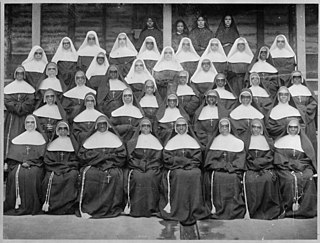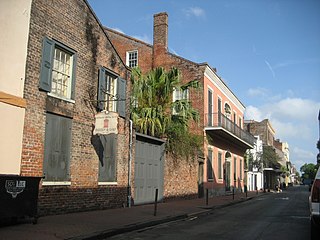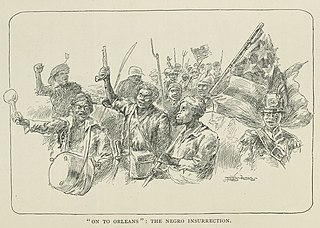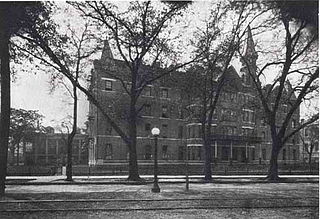
The French Quarter, also known as the Vieux Carré, is the oldest neighborhood in the city of New Orleans. After New Orleans was founded in 1718 by Jean-Baptiste Le Moyne de Bienville, the city developed around the Vieux Carré, a central square. The district is more commonly called the French Quarter today, or simply "The Quarter", related to changes in the city with American immigration after the 1803 Louisiana Purchase. Most of the extant historic buildings were constructed either in the late 18th century, during the city's period of Spanish rule, or were built during the first half of the 19th century, after U.S. purchase and statehood.

Pierre Gustave Toutant-Beauregard was an American military officer known as being the Confederate General who started the American Civil War at the battle of Fort Sumter on April 12, 1861. Today, he is commonly referred to as P. G. T. Beauregard, but he rarely used his first name as an adult. He signed correspondence as G. T. Beauregard.
Marie Catherine Laveau was a Louisiana Creole practitioner of Voodoo, herbalist and midwife who was renowned in New Orleans. Her daughter, Marie Laveau II, also practiced rootwork, conjure, Native American and African spiritualism as well as Louisiana Voodoo and traditional Roman Catholicism. An alternate spelling of her name, Laveaux, is considered by historians to be from the original French spelling.
Charles Deslondes was an African American revolutionary who was one of the leaders in the 1811 German Coast uprising, a slave revolt that began on January 8, 1811, in the Territory of Orleans. He led more than 500 rebels against the plantations along the Mississippi River toward New Orleans. White planters formed militias and ended up hunting down the rebels.

Fort de Chartres was a French fortification first built in 1720 on the east bank of the Mississippi River in present-day Illinois. It was used as the administrative center for the province, which was part of New France. Due generally to river flooding, the fort was rebuilt twice, the last time in limestone in the 1750s in the era of French colonial control over Louisiana and the Illinois Country.

Frances Parkinson Keyes was an American author who wrote about her life as the wife of a U.S. Senator and novels set in New England, Louisiana, and Europe. A convert to Roman Catholicism, her later works frequently featured Catholic themes and beliefs. Her last name rhymes with "eyes," not "keys."

Louisiana Creoles are a Louisiana French ethnic group descended from the inhabitants of colonial Louisiana before it became a part of the United States during the period of both French and Spanish rule. They share cultural ties such as the traditional use of the French, Spanish, and Creole languages and predominant practice of Catholicism.

The Sisters of the Holy Family are a Catholic religious order of African-American nuns based in New Orleans, Louisiana. They were founded in 1837 as the Congregation of the Sisters of the Presentation of the Blessed Virgin Mary by Henriette DeLille. They adopted the current name in 1842.

Esplanade Avenue is a historic street in New Orleans, Louisiana. It runs northwest from the Mississippi River to Beauregard Circle at the entrance to City Park.

The buildings and architecture of New Orleans reflect its history and multicultural heritage, from Creole cottages to historic mansions on St. Charles Avenue, from the balconies of the French Quarter to an Egyptian Revival U.S. Customs building and a rare example of a Moorish revival church.

The Hermann–Grima House is a historic house museum in the French Quarter of New Orleans, Louisiana, United States. The meticulously restored home reflects 19th century New Orleans. It is a Federal-style mansion with courtyard garden, built in 1831. It has the only extant horse stable and 1830s open-hearth kitchen in the French Quarter.

Madame John's Legacy is a historic house museum at 632 Dumaine Street in the French Quarter of New Orleans, Louisiana. Completed in 1788, it is one of the oldest houses in the French Quarter, and was built in the older French colonial style that was still prevalent in New Orleans at that time. It was declared a National Historic Landmark in 1970 for its architectural significance. The Louisiana State Museum owns the house and provides tours.

Peychaud's bitters is a bitters distributed by the American Sazerac Company. It was originally created between 1849 and 1857 by Antoine Amédée Peychaud, a Creole apothecary from the French colony of Saint-Domingue who traveled to New Orleans, Louisiana, around 1793. It is a gentian-based bitters, comparable to Angostura bitters, but with a predominant anise aroma combined with a background of mint. It is currently produced at the Buffalo Trace Distillery in Frankfort, Kentucky.

The 1811 German Coast uprising was a slave rebellion which occurred in the Territory of Orleans from January 8–10, 1811. It occurred on the east bank of the Mississippi River in the modern-day Louisiana parishes of St. John the Baptist, St. Charles and Jefferson. The rebellion was the largest of its kind in the history of the United States, but the rebels only killed two white men. Confrontations with U.S. military personnel and local militiamen who were sent to suppress the rebellion, combined with post-trial executions, resulted in the deaths of 95 rebels.

New Orleans University was a historically black college that operated between 1869 and 1935 in New Orleans, Louisiana, United States. It was founded by Freedmen's Aid Society and the Methodist Episcopal Church. It merged with Straight College in 1935 to form Dillard University.

Kerner House is a historic house located at 1012 Monroe Street in Gretna, Louisiana, United States. The house was built sometime in the 1870s by the Kerner family. the house is a one-story frame raised cottage in Greek Revival/Italianate style. The house is currently privately owned and is in a state of disrepair and is heavily damaged by plant growth and termites.

Major D'Aquin's Battalion of Free Men of Color was a Louisiana Militia unit consisting of free people of color which fought in the Battle of New Orleans during the War of 1812. The unit's nominal commander was Major Louis D'Aquin, but during the battle it was led by Captain Joseph Savary. Consisting of four companies, it distinguished itself during an American sortie against a British encampment on the night of December 23, 1814 and during the main battle near New Orleans on January 8, 1815. After the battle, General Andrew Jackson, who had held overall command of all U.S. forces present, praised the unit for their performance during the engagement.

The Herb House is a historic building located in downtown Savannah, Georgia, United States. Some sources claim it to be built in the 18th century, which would have made it the oldest extant building in the state of Georgia; however, its construction in local handmade brick puts this in doubt. Other sources give a construction year of 1853, which is the first year it appears on a map. The building is now part of the restaurant Pirates' House, the buildings for which both pre- (1794) and post-date (1871) it.

In New Orleans, a gallery is a wide platform projecting from the wall of a building supported by posts or columns. Galleries are typically constructed from cast iron with ornate balusters, posts, and brackets.
Roulhac Bunkley Toledano is an American writer, historian and preservationist. She has written and contributed to several publications, including volume five of the New Orleans Architecture series, titled The Esplanade Ridge (1977) and The National Trust Guide to Savannah (1997).























